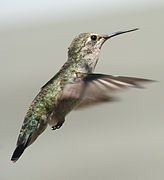Adaptation
Anna’s hummingbird is unique organism because of its
relatively small size. Only weighing 3-6 grams and measuring
about 10 centimeters long, Anna’s hummingbird is much smaller
than the typical flying vertebrate (The Cornell Lab of
Ornithology 2011). Their bills are short and straight that
connects to a long, flat forehead. Anna’s hummingbirds have a
green iridescent back and a gray colored stomach (BirdWeb). As
observed in many species, the males are brightly colored and
easy to identify because their entire heads and throats are
colored a flashy iridescent red (BirdWeb). The females have a
small amount of red on their throats but have a mostly green
head (BirdWeb).
Though Calypte anna is a medium-sized hummingbird, it is much
smaller than almost every other species of bird creating
challenges that the organism must evolutionarily overcome. One
huge challenge faced by Anna’s hummingbird is regulating their
metabolism because of their small size and fast wingbeat.
Another challenge that Anna’s hummingbirds face is flying in the
rain, which is problematic because of their small size yet
again.
 Hummingbirds’ exhibit extremely high mass-specific metabolic
rates partially because of their small size and partially
because of their unique attribute of being able to sustain
hovering flight (Evangelista et al. 2010). With being only
about 10 cm long and weighing only 3-6 grams, Anna’s hummingbird
faces the challenge of sustaining adequate body temperature
because their surface area is much greater than their volume,
meaning they have more area for heat lost (The Wild Bird Store
2014). A hummingbird often has to eat its weight in nectar
every day in order to keep up with their high metabolic demands
(The Wild Bird Store 2014)! One way hummingbirds can overcome
this massive heat loss is by entering
nocturnal torpor, a
significantly lowered body temperature at night (Evangelista et
al. 2010). Another way that is believed to compensate for this
costly mass-specific metabolic rate is that Anna’s hummingbird
passively absorbs glucose in their intestines instead of relying
solely on cell mediated transport, saving them energy when
digesting food (McWhorter et al. 2005). Sustained hovering is a
very demanding and costly form of flying that requires high
metabolic input (Evangelista et al. 2010).
Hummingbirds’ exhibit extremely high mass-specific metabolic
rates partially because of their small size and partially
because of their unique attribute of being able to sustain
hovering flight (Evangelista et al. 2010). With being only
about 10 cm long and weighing only 3-6 grams, Anna’s hummingbird
faces the challenge of sustaining adequate body temperature
because their surface area is much greater than their volume,
meaning they have more area for heat lost (The Wild Bird Store
2014). A hummingbird often has to eat its weight in nectar
every day in order to keep up with their high metabolic demands
(The Wild Bird Store 2014)! One way hummingbirds can overcome
this massive heat loss is by entering
nocturnal torpor, a
significantly lowered body temperature at night (Evangelista et
al. 2010). Another way that is believed to compensate for this
costly mass-specific metabolic rate is that Anna’s hummingbird
passively absorbs glucose in their intestines instead of relying
solely on cell mediated transport, saving them energy when
digesting food (McWhorter et al. 2005). Sustained hovering is a
very demanding and costly form of flying that requires high
metabolic input (Evangelista et al. 2010).
Sustained hovering requires both aerobic and anaerobic
metabolism, demonstrating the demanding energetic cost of this
action (Altshuler et al. 2010). Selection has favored
hummingbirds that have fast oxidative-glycolytic muscle fibers
in their wings which allows for quick response and fatigue
resistence (Altshuler et al. 2010). The hummingbird has also
developed (likely through selection) a high degree of synchrony
within the pectoral muscles and a specialized motor endplate
pattern which includes two curivilinear bands which concentrate
the motor endplates to the center of the muscles (Altshuler et
al. 2010). This differs from the regular grid-like pattern
observed in all other birds and allows for the rapid beating of
the hummingbirds wings (Altshuler et al. 2010).
Another structural adaption acquired by Anna’s hummingbird is
hydrophobic wings (Ortega-Jimenez, V.M. and R. Dudley 2012).
Due to their high metabolic demands, hummingbirds cannot go more
than a day without feeding, requiring adaptions to all weather
conditions including the heaviest of rains. Rain poses a
challenge to flight because the water droplets can alter the
mass of the wings and body of birds, impacting the wing’s
inertia as well as requiring more power to stay airborne against
the downward force of the rain drops (Ortega-Jimenez, V.M. and
R. Dudley 2012). Anna’s hummingbird has wings which are both
water repellant and wings that deter water penetration which
allows them to remain highly active without any loss of control
during even the heaviest of rain (Ortega-Jimenez, V.M. and R.
Dudley 2012).
